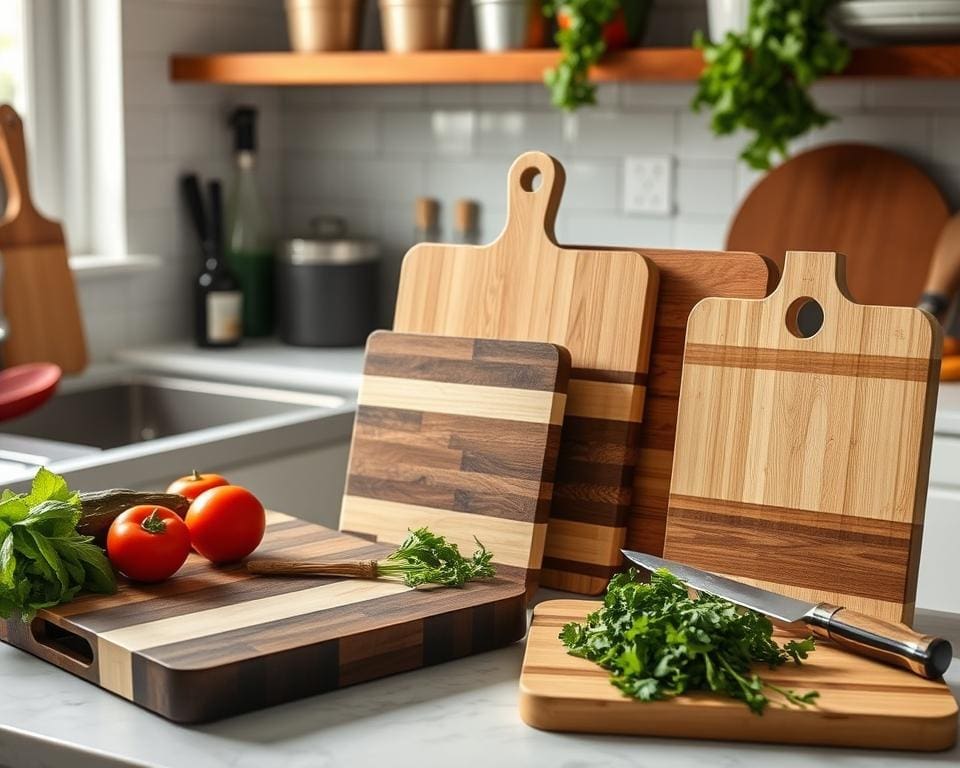In the culinary world, the importance of reliable kitchen tools cannot be overstated. Among them, the most durable cutting boards stand out as a vital piece of equipment that enhances both cooking efficiency and food safety. Selecting the right cutting board can significantly affect your culinary experience, with options such as John Boos and OXO leading the pack in quality and durability. Investing in kitchen cutting boards that are built to last not only safeguards your health by reducing cross-contamination but also proves to be economically sensible, as the best cutting boards decrease the frequency of replacements over time.
Moreover, cutting boards can serve as aesthetic additions to your kitchen, elevating its overall style. Whether you prefer the warmth of wood or the sleekness of plastic, finding a cutting board that balances durability with design can truly transform your cooking space. This article will guide you through the essentials of choosing the most durable cutting boards, ensuring your cooking adventures are both safe and stylish.
Why Durability Matters in Kitchen Cutting Boards
Choosing the right cutting boards for cooking is essential for both the culinary experience and the safety of your food. When considering kitchen tools, Durability Matters significantly. It not only influences the performance of your cutting board but also plays a crucial role in maintaining health standards in your kitchen.
The Impact on Food Safety
A durable cutting board can greatly reduce the risk of bacteria accumulation. Research indicates that wooden boards possess natural antimicrobial properties, leading to enhanced food safety. Unlike plastic, which can develop deep grooves where bacteria may thrive, sturdy wooden surfaces offer better hygiene when properly maintained. The combination of durability and proper care ensures that the cutting board remains a safe tool in food preparation, protecting both your health and the quality of ingredients.
Long-Term Cost Efficiency
Investing in high-quality, durable cutting boards for cooking represents long-term cost efficiency. While cheaper options may seem appealing, they often require frequent replacement, leading to increased expenses over time. By selecting robust materials such as hardwood or high-grade plastic, you ensure that your cutting board lasts longer. This longevity not only saves money but also diminishes environmental waste, contributing positively to your household budget and the planet.

The Most Durable Cutting Boards for Your Kitchen
When selecting the best cutting boards, the choice of material plays a vital role in determining longevity and performance. Various materials offer distinct advantages, ensuring that your durable cutting boards meet both aesthetic and functional needs in the kitchen. Understanding these top materials helps in making a thoughtful investment for everyday culinary tasks.
Top Materials for Longevity
For those seeking durable cutting boards, hardwoods like maple, hickory, and lignum vitae are excellent options. These materials are known for their resistance to warping and scratching, enhancing the board’s lifespan. Furthermore, the rich textures and colours provided by hardwood can elevate the kitchen’s ambience.
On the other hand, plastic options such as polypropylene are gaining popularity due to their resilience and ease of maintenance. These boards are not only durable but also lightweight, making them a practical choice for busy kitchens. Their non-porous surface resists staining and is dishwasher-safe, ensuring effortless cleanliness.
Choosing the Right Size for Your Needs
The right size of cutting board significantly depends on individual cooking habits. Large cutting boards are perfect for extensive meal preparations, providing ample space for chopping, slicing, and dicing. In contrast, small cutting boards excel in quick tasks and can easily be stored away when not in use. Selecting the appropriate size ensures efficiency in food preparation and enhances the overall cooking experience.
Wooden Cutting Boards: A Timeless Choice
When considering the heart of your kitchen, wooden cutting boards stand out as a timeless choice. Their enduring charm and functional benefits elevate the culinary experience while exemplifying the beauty of natural materials.
The Benefits of Hardwoods
Hardwood cutting boards offer numerous advantages, making them highly sought after. First, the strength of hardwoods provides durability, ensuring they withstand the rigours of daily use. The aesthetic appeal of these boards adds a warm and inviting touch to any kitchen. Notably, wooden cutting boards possess a remarkable ability to self-heal from knife marks, maintaining their visual integrity over time. This unique feature contributes to their longevity, showcasing the benefits of hardwoods as both practical and beautiful.
Care and Maintenance Tips
To sustain the quality of your wooden cutting boards, regular care is essential. Cleaning should involve warm, soapy water rather than harsh chemicals, which can strip the wood of its natural oils. After washing, it’s important to dry the board thoroughly to prevent warping. Periodic oiling with food-safe mineral oil can help protect the wood from cracking and drying out. By investing time into care, you ensure that your wooden cutting boards for chopping remain a cherished kitchen companion for years to come.
Plastic Cutting Boards: Modern Durability
Plastic cutting boards have gained popularity for their practicality and ease of use. Their modern durability sets them apart from traditional wooden boards, making them an ideal choice for any kitchen. With a range of benefits, these boards offer a compelling alternative.
Advantages Over Wooden Boards
The advantages of plastic cutting boards are numerous. First and foremost, they are lightweight, which enhances their usability in a bustling kitchen environment. Unlike wooden boards, plastic options are dishwasher safe, allowing for effortless cleaning. This feature promotes hygiene, as they are less porous, reducing the risk of bacteria retention.
- Lightweight and easy to handle
- Dishwasher safe for convenient cleaning
- Less porous, promoting better hygiene
Best Practices for Cleaning
Ensuring the longevity of plastic cutting boards relies on proper maintenance. Adhering to guidelines for cleaning cutting boards can help prevent scratches and maintain their surface integrity. Here are some best practices:
- Wash with warm soapy water after each use.
- Use a non-abrasive sponge to avoid scratching.
- For sanitizing, a solution of vinegar and water can be effective.
- Avoid soaking to prevent warping.
Bamboo Cutting Boards: Eco-Friendly Options
Bamboo cutting boards have garnered attention for their sustainable qualities and eco-friendly options. This remarkable material is not only renewable but also boasts a rapid growth rate, positioning it as a favourable choice for environmentally conscious consumers. Understanding the balance between benefits and drawbacks enhances the decision-making process for anyone considering bamboo for their kitchen.
Understanding the Sustainability Factor
Bamboo is known for its minimal environmental footprint. Since it can grow up to three feet in a single day, its cultivation leads to less deforestation compared to hardwoods. This rapid growth makes bamboo an excellent candidate for sustainable kitchenware. Furthermore, its resilience ensures that bamboo cutting boards require fewer resources throughout their lifecycle, aligning with the principles of sustainability.
Pros and Cons of Bamboo Boards
As with any product, bamboo cutting boards present both advantages and disadvantages. Among the pros are:
- Lightweight nature, making them easy to handle.
- Affordability in comparison to traditional wooden boards.
- Attractive aesthetic that adds charm to any kitchen.
On the other hand, users should consider the potential cons:
- Risk of splitting if not properly maintained.
- Regular oiling necessary to preserve the board’s integrity.
- May vary in quality depending on the brand.
Exploring these pros and cons of bamboo boards reveals a well-rounded understanding of their role in sustainable kitchen practices.
Choosing Between Large and Small Cutting Boards
When selecting the right cutting board, understanding your cooking habits is vital. Large cutting boards offer the space needed for preparation tasks that require ample room, such as carving meats or chopping large vegetables. These boards not only provide a stable surface but also enable you to work efficiently, minimising mess and enhancing your overall cooking experience.
Conversely, small cutting boards are perfect for quick slicing tasks, making them ideal for smaller kitchens or when you need to save space. They can easily be stored away and are often lighter, making them easier to handle for quicker tasks. Incorporating various sizes into your kitchen arsenal allows for unparalleled versatility. For instance, using a large board for meal prep and switching to a small board for quick ingredient additions can streamline your cooking process significantly.
Ultimately, the right choice between large and small cutting boards hinges on your unique needs and cooking style. Users from various culinary backgrounds have reported that pairing a large board for foundational tasks with a small board for immediate use not only optimises their kitchen efficiency but also enhances their enjoyment of the cooking process. So, as you consider your options, think about how choosing cutting boards of different sizes can elevate your culinary experience.









